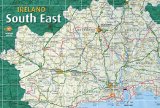South East Ireland Tourism
Travel guide to Ireland's south east
Travel guide to Ireland's south east
Kilkenny City, Kilkenny
Long renowned as Ireland’s Medieval Capital, the city’s origins date back more than 1,500 years ago. Kilkenny, from the Gaelic Cill Ceannaigh, derives its name from a 6th century monk called Saint Canice.
Characterised by beautifully restored old buildings and covered slipways, Kilkenny City is small and compact enough to explore on foot, yet full of fascinating, historical buildings, and contemporary shops, design galleries cafés and restaurants.
The great building prowess of the Normans is very evident in the 11th and 12th century structures they bestowed on the city. Not alone in the large “set piece” buildings, such as St. Canice’s Cathedral, the imposing Butler castle, the four surviving medieval abbeys, but also the linear streetscape, especially the attractive, covered stepped slipways.
The 17th century was a time of great social and political turmoil for Kilkenny. It was the seat of the national parliament for a six-year period, the infamous Oliver Cromwell invaded the city in 1650 and Kilkenny College (another superb building in John Street, now serving as County Hall) was attended by such luminaries as Jonathan Swift and George Berkeley. This may mark the beginning of the lively cultural and intellectual movement that still thrives there.
The Normans arrived in the 12th century and their legacy remains in the superb and fully restored Kilkenny Castle, and in the thriving and cosmopolitan merchant city.
Rothe House, owned by Kilkenny Archaeological Society, is an example of a typical merchant's house of the Tudor period (built by John Rothe between 1594 and 1610), which features a fine period costume display, an interesting collection of pictures and artefacts of Kilkenny’s past, and frequent visiting exhibitions. It houses the County Genealogical Centre.
The Black Abbey was founded in the 13th century by the Dominican Order.
A great Kilkenny story is that of Dame Alice Kyteler, who ran an inn and a healthy moneylending business. Not so healthy were her husbands – she buried four of them in quick succession! Accused of witchcraft, Dame Alice fled, but her handmaiden, Maid Petronella of Meath was burned at the stake. Kytelers Inn has been restored and is still providing sustenance today.
The 20th century saw Kilkenny’s rise as a creative centre, and the city is home to many craft and design shops, offering everything from knitwear and leather goods to jewellery, candles and pottery. Perhaps best known is the Kilkenny Design Centre and Workshops, located opposite Kilkenny Castle. Explore the side streets to find truly beautiful craft and design items made here in Kilkenny.
For an on-the-ground experience of Kilkenny, take one of the regular walking tours, which depart from the Tourist Office. They will introduce you to the highlights of Kilkenny within a short space of time and give you an insight into the history of this beautiful city.
If you are visiting Kilkenny Castle, include a visit to the Rose Garden overlooking the River Nore.
Equestrian and golf enthusiasts are well catered for in the vicinity, and there are many other sporting and activity centres in and around Kilkenny City.
If planning a visit to Kilkenny, why not plan around one of the many festivals that take place in Kilkenny throughout the year?
If you are using Kilkenny as a touring base, this is the start of the well signposted scenic/historic touring route to Cashel.
<< Return to Kilkenny page
Characterised by beautifully restored old buildings and covered slipways, Kilkenny City is small and compact enough to explore on foot, yet full of fascinating, historical buildings, and contemporary shops, design galleries cafés and restaurants.
The great building prowess of the Normans is very evident in the 11th and 12th century structures they bestowed on the city. Not alone in the large “set piece” buildings, such as St. Canice’s Cathedral, the imposing Butler castle, the four surviving medieval abbeys, but also the linear streetscape, especially the attractive, covered stepped slipways.
The 17th century was a time of great social and political turmoil for Kilkenny. It was the seat of the national parliament for a six-year period, the infamous Oliver Cromwell invaded the city in 1650 and Kilkenny College (another superb building in John Street, now serving as County Hall) was attended by such luminaries as Jonathan Swift and George Berkeley. This may mark the beginning of the lively cultural and intellectual movement that still thrives there.
Things to see and do in Kilkenny City
St. Canice's memory lives on in Kilkenny, not least in the beautifully preserved St. Canice’s Cathedral built overlooking the city in the 13th century.The Normans arrived in the 12th century and their legacy remains in the superb and fully restored Kilkenny Castle, and in the thriving and cosmopolitan merchant city.
Rothe House, owned by Kilkenny Archaeological Society, is an example of a typical merchant's house of the Tudor period (built by John Rothe between 1594 and 1610), which features a fine period costume display, an interesting collection of pictures and artefacts of Kilkenny’s past, and frequent visiting exhibitions. It houses the County Genealogical Centre.
The Black Abbey was founded in the 13th century by the Dominican Order.
A great Kilkenny story is that of Dame Alice Kyteler, who ran an inn and a healthy moneylending business. Not so healthy were her husbands – she buried four of them in quick succession! Accused of witchcraft, Dame Alice fled, but her handmaiden, Maid Petronella of Meath was burned at the stake. Kytelers Inn has been restored and is still providing sustenance today.
The 20th century saw Kilkenny’s rise as a creative centre, and the city is home to many craft and design shops, offering everything from knitwear and leather goods to jewellery, candles and pottery. Perhaps best known is the Kilkenny Design Centre and Workshops, located opposite Kilkenny Castle. Explore the side streets to find truly beautiful craft and design items made here in Kilkenny.
For an on-the-ground experience of Kilkenny, take one of the regular walking tours, which depart from the Tourist Office. They will introduce you to the highlights of Kilkenny within a short space of time and give you an insight into the history of this beautiful city.
If you are visiting Kilkenny Castle, include a visit to the Rose Garden overlooking the River Nore.
Equestrian and golf enthusiasts are well catered for in the vicinity, and there are many other sporting and activity centres in and around Kilkenny City.
If planning a visit to Kilkenny, why not plan around one of the many festivals that take place in Kilkenny throughout the year?
If you are using Kilkenny as a touring base, this is the start of the well signposted scenic/historic touring route to Cashel.
Kilkenny City Map
<< Return to Kilkenny page






